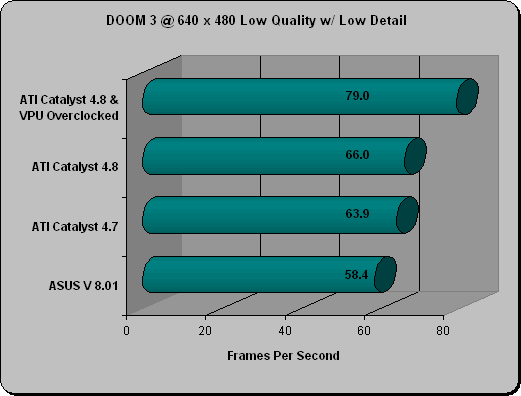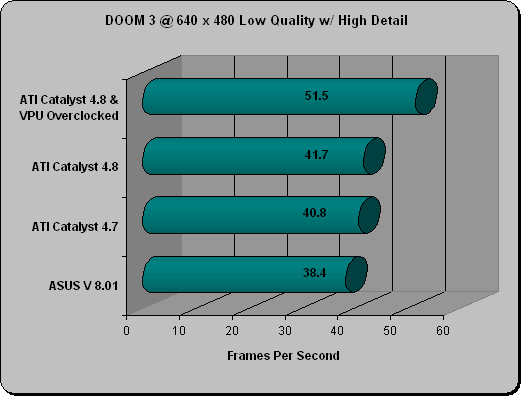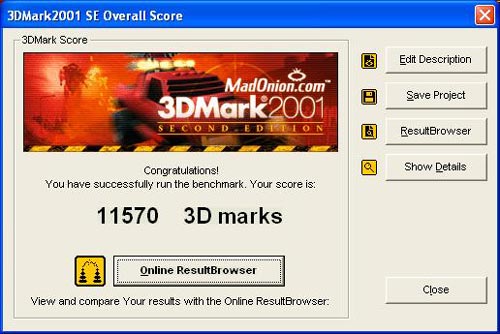Building A Whitebox Notebook: Part 3
Our Test System
- ASUS M6N Notebook
- Intel Pentium-M 1.7
- ATI Mobility 9600 64mb
- Kingston PC-2700 2 x 512mb 200-pin SO-DIMM’s
- 40GB Fujitsu 5400RPM Hard Drive
- Windows XP Professional w/ SP1A & DirectX 9.0B
Video Benchmarking
As you can tell most of our tweaking came from tinkering with the ATI mobility VPU. First we modified desktop CATALYST drivers to work on our notebook, and then we used ATI Tool to overclock the VPU on out notebook. While this may sound extreme the results speak for themselves. A quick and free test that anyone can do to compare their results to ours is 3DMark2001 SE.
|
|
Before installing the CATALYST 4.8 drivers we were getting 3DMark2001 scores around 9450 and after installing the desktop drivers our score went up 100 points. The true improvement is with the desktop driver is video quality in newer games, not synthetic video benchmarks. Now let’s take a look at our performance levels after overclocking the video card.
|
|
After overclocking the Mobility 9600 to 475MHz/240MHz we noted a huge jump in 3DMark 2001 SE scores! We gained 2,012 point increase in our score! Just by overclocking the ATI Mobility 9600 we noted a 21% increase in video performance! While that is all good it does not mean you will see a 21% increase in the world or real games — or does it?
DOOM 3 Benchmarking
Test Settings
- High Detail: High Quality Special Effects, Enabled: Shadows, Specular, & Bump Maps
- Low Detail: All the above disabled
It should be noted that the first time demo run was ignored so the game could be cached. We then took the average of the 2nd to 4th runs to get the numbers shown in the graphs.

When you use the ASUS M6N with the proper notebook drivers from ASUS you get 58.4 frames per second (FPS) in DOOM 3 with everything on low at the lowest possible resolution. After our driver tweaks and a little overclocking we were able to get our notebook up to 79.0 frames per second in DOOM 3! That is a 20.6FPS or a 26% improvement in performance for free! If you notice just by changing to the desktop CATALYST 4.8 driver we saw a noticeable 8 FPS increase in performance. Let’s take a look at high quality, because a game like DOOM 3 deserves to be played with all the features on.

With all the eye candy turned on we see an amazing 34% increase in performance over the default drivers. A jump from 38FPS to 52FPS is an amazing performance increase and game play is noticeably smoother. We just took our ASUS M6N series notebook with a timid ATI 9600 64mb VPU from being above average to being a killer gaming notebook. It looks like our tweaks have been very successful!
Thoughts & Discussion
Building the ASUS M6N notebook was very simple and easy to do. The hardest part was finding all the pieces, but when doing something ground breaking someone must first pave the way. During the writing of this series many enthusiasts have gone on to build their own notebooks with great success. Over the past several months more and more retailers have begun to offer whitebox notebooks, thus proving that the market is starting to notice that Do-It-Yourself notebooks is something that could possibly explode over the next couple years. With companies like Intel and ASUS paving the way hopefully consumers will continue to see more options for their next notebook purchase. The days of having only a few notebook chassis to pick from are hopefully coming to an end!
Overall our experience with the ASUS M6N has been great. We have taken our M6N to china, countless plane flights, and events like Quakecon 2004. During this time period we have spent months overclocking and pushing our platform to its limits. During the entire time we have yet to have a single blue screen or issue with the notebook in design or operation. As for the size of the notebook it is a bit large for the frequent traveler, but for those who only travel for monthly business trips it is not bad. It weighs in just over 6lbs once fully assembled. Battery life in “battery saving” mode is just shy of 5 hours, while we can get a solid 2 hours and 12 minutes of “high performance” gaming use. The 15.4″ wide screen display that the ASUS M6N uses actually worked out very well. Many gamers question having a wide screen and now after using one for months I will not go back to a normal square screen monitor. Gaming on a wide screen is fine and we never noted any distortion that stood out or bothered us over that of a regular screen.
While the keyboard felt nice the only complaint from people who tried out our ASUS M6N notebook was with the cooling solution for the processor. The hot exhaust from the processor heat sink blows directly out from the right back corner. When a right handed user happens to use the system with a mouse plugged in, the hot air blows on his hand. While it never bothered me some people commented on it, so it is something to point out for those who use mice with their notebooks and don’t want hot air blown on their hand.
The Intel Pentium-M processor is by far one of, if not the best, products in Intel’s CPU arsenal. With features like SpeedStep technology and the ability to get various low power consumption processors the Pentium-M can suit many purposes. This allows the Pentium-M processor to suit anyone from the frequent traveler wanting the longest battery life to the gamer who wants the best gaming performance possible with a thin notebook. Intel has also pushed retail boxed versions of their processors into the market, which are widely available. It is clear by this that Intel is fully supporting consumers who want the ability to upgrade their old notebook and/or build a custom notebook from scratch. The crew over on the green side of things seems to think very differently of this market. AMD is not pushing their Athlon 64 Mobile CPU for the Do-It-Yourself (DIY) user and when we started in our search to build a custom notebook we could not find any Athlon 64 Mobile processors on the market. Just recently consumers can find several AMD 64 Mobile processors on the market, so users are not limited to Intel processors now. After talking to AMD while attending IDF we spoke about this article and our build up and they are not planning on pushing into this market right now. Hopefully AMD will catch on or Intel will gain pretty much the entire mobile processor notebook market for the DIY builders.
When we thought of building our own notebook we thought outside of the box and did something that not many hardware sites have done. The results have been amazing and in the long run hopefully this article series will help spark interest for this new and upcoming market. We are going to continue our coverage of products in the notebook market and will strive to point out to the hardware companies that consumer interest is strong!



Comments are closed.